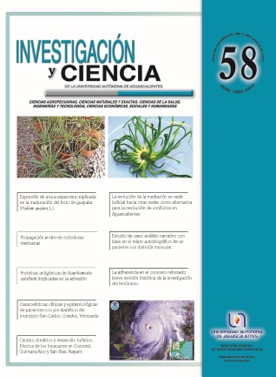Antigenic proteins of Acanthamoeba castellanii involved in adhesion
DOI:
https://doi.org/10.33064/iycuaa2013583991Keywords:
Acanthamoeba castellanii, antigenic proteins, adhesionAbstract
Acanthamoeba castellanii is an opportunistic pathogen agent causing infections such as keratitis, encephalitis and skin infections. Actually, the acantamoebiosis is a health problem, with unselective and toxic drugs. The adhesion ability of A.castellanii by tissues of the host cell is essential to the development of infection. This study analyzes the antigenic proteins and their role in adherence
of the parasite to the host cells. The results show eight antigenic proteins of Mr ≤ 180, 174, 124, 113, 84, 49, 43 and 40 kDa, localized in the trophozoite surface. Furthermore the parasite-host interaction assays using polyclonal antibodies, indicating a decrease in adhesion (90%) of the trophozoite to the host cell.
Downloads
Metrics
References
• CHANG, S., Small, free-living amebas: cultivation, quantitation, identification, classification, pathogenesis, and resistance. Current Topics on Comparative Pathobiology., 1: 201-254, 1971.
• COONS, A., LEDUC, E., CONNOLLY, J., Studies on antibody production: a method for the histochemical demonstration of specific antibody and its application to a study of the hyperimmune rabbit. The Journal of Experimental Medicine, 102: 49-60, 1955.
• GARATE, M., CUBILLOS, I., MARCHANT, J., PANJWANI, N., Biochemical characterization and functional studies of Acanthamoeba mannose-binding protein. Journal: Infection and Immunity, 73: 5775-5781, 2005.
• HADAS, E., MAZUR., T., Proteolytic enzymes of pathogenic and non-pathogenic strains of Acanthamoeba spp. Tropical Medicine And Parasitology, 44: 197-200, 1993.
• HAUCK, C., Cell adhesion receptors–signaling capacity and exploitation by bacterial pathogens. Medical Microbiology and Immunology, 191: 55-62, 2002.
• KENNETT, M. J., HOOK, R. R., FRANKLIN, C. L., RILEY, L. K., Acanthamoeba castellanii: characterization of an adhesin molecule. Experimental Parasitology, 92: 161-169, 1999.
• KERR, J., Cell adhesion molecules in the pathogenesis of and host defense against microbial infection. Journalof Clinical Pathology, 52: 220-230, 1999.
• LEHER, H., ALIZADEH, H., TAYLOR, W., SHEA, A., SILVANY, R., VAN KLINK, F., JAGER, M., NIEDERKORN, J., Role of mucosal IgA in the resistance to Acanthamoeba keratitis. Investigative Ophthalmology and Visual Science, 39: 2666-2673, 1998.
• MARCIANO-CABRAL, F., CABRAL, G. A., Acanthamoeba spp. as agents of disease in humans. Clinical Microbiology Reviews, 16: 273-307, 2003.
• MATIN, A., RYOUL JEONG, S., STINS, M., KHAN, N. A., Effects of human serum on Balamuthia mandrillaris interactions with human brain microvascular endothelial cells. Journal of Medical Microbiology, 56: 30-35, 2007.
• NORIEGA, L., SOSA, A., SABANERO, L., ÁVILA, M., Influence of pulsed magnetic fields on the morphology of bone cells in early stage of growth. Micron, 42: 600-607, 2011.
• ROCHA-AZEVEDO, B., JAMERSON, M., CABRAL, G., SILVA-FILHO, F., MARCIANO-CABRAL, F., Acanthamoeba interaction with extracellular matrix glycoproteins: biological and biochemical characterization and role in cytotoxicity and invasiveness. Journal of Eukaryotic Microbiology, 56: 270-278, 2009.
• SIDDIQUI, R., KHAN, N. A., Biology and pathogenesis of Acanthamoeba. Parasites & Vectors, 5: 6, 2012.
• TOWBIN, H., STAEHELIN, T., GORDON, J., Electrophoretic transfer of proteins from polyacrilamid gels to nitrocellulose sheets: procedure and some applications. Proceedings of The National Academy Of Sciences, 76: 4350-4354, 1979.
• VISVESVARA, G., MOURA, H., SCHUSTER, F., Pathogenic and opportunistic free-living amoebae: Acanthamoeba spp., Balamuthia andrillaris, Naegleria fowleri, and Sappinia diploidea. FEMS Immunology & Medical Microbiology, 50: 1-26, 200
Downloads
Published
How to Cite
License
Copyright (c) 2013 José Alberto Juárez Rodríguez, Gloria Barbosa Sabanero, José de Jesús Serrano Luna, Lérida Liss Flores Villavicencio, Mineko Shibayama Salas, Myrna Sabanero López

This work is licensed under a Creative Commons Attribution-NonCommercial-ShareAlike 4.0 International License.
Las obras publicadas en versión electrónica de la revista están bajo la licencia Creative Commons Atribución-NoComercial-CompartirIgual 4.0 Internacional (CC BY-NC-SA 4.0)









